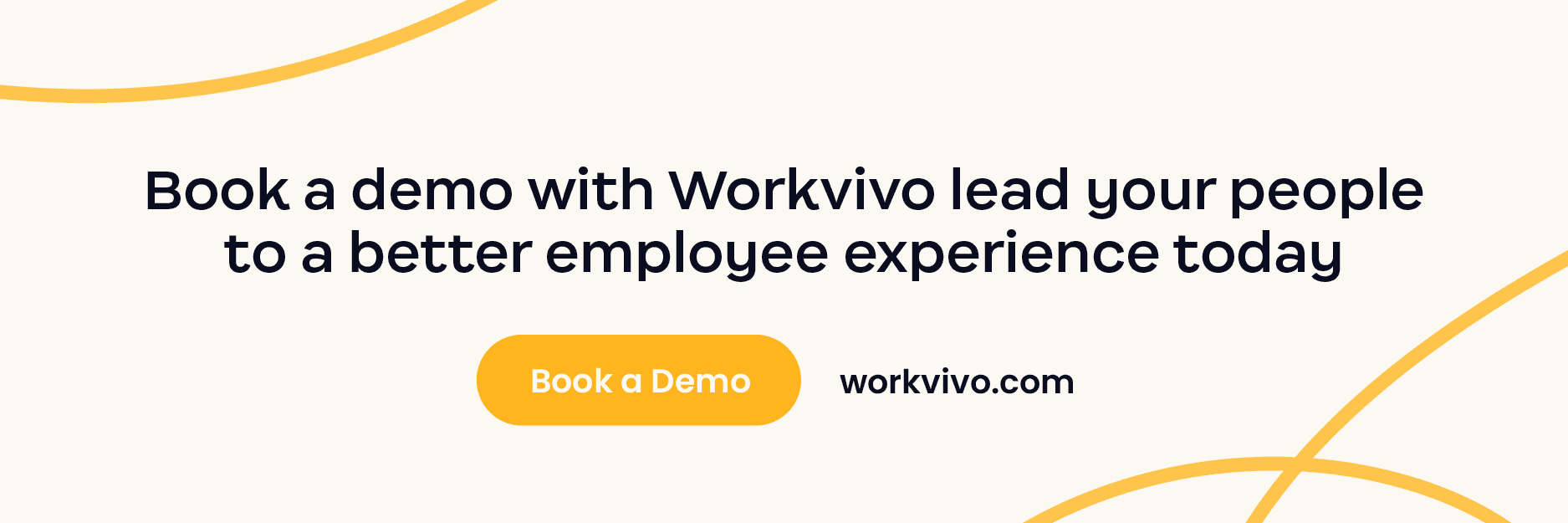Learn what 7,500+ frontline workers feel about culture, communication, and recognition
An Employee Experience Platform (EXP) is a solution designed to improve the overall employee experience during their journey within an organization.
This journey spans their entire duration with the organization — from recruitment and onboarding, daily operations and development, to eventual offboarding or transition.
The main goal of the employee experience platform is to streamline processes, foster engagement, and cultivate a positive workplace culture, thereby maximizing the overall employee experience.
But before we dive deeper into EXP, let’s define the key terms involved — “employee experience” and “platform.”
What is Employee Experience?
Employee Experience, in this case, encompasses interactions, emotions, and impressions that an employee experiences during their time with a company.
It’s a term that extends beyond mere job tasks. It embodies the quality of relationships with coworkers, the nature of work-life balance, the perception of the company’s values and cultures, and the overall sense of fulfillment derived from the job.
What is a Platform?
In the context of an EXP, a platform is a tool that integrates all the crucial functionalities necessary to improve the employee experience.
It usually includes features for communication, collaboration, performance management, learning and development, HR services, and more.
What’s the Difference Between Employee Experience and Employee Engagement?
The term “employee experience” and “employee engagement” are often used interchangeably. And while they both aim to improve employees’ work experience, they mean different things.
Employee Experience
The employee experience encompasses every phase of the employee’s journey with the organization. It includes tangible elements like compensation and benefits, work environment, and job role, as well as intangible aspects such as organizational culture, management styles, and growth opportunities.
Employee Engagement
Employee engagement measures an employee’s commitment, passion, and investment in their work and their organization. Often, we can categorize engaged employees as those who strive to further their organization’s reputation and interests.
The key difference between the two lies in their scope and focus:
- Scope. Employee experience covers a broader range than employee engagement. It looks at every touchpoint in an employee’s life cycle within the organization. In contrast, employee engagement focuses on the employee’s emotional connection and commitment to their work and employer.
- Focus. Employee experience is about creating an environment that fosters satisfaction and productivity at every stage of the employee’s journey. It considers all the factors that impact an employee’s perception of their workplace. In contrast, employee engagement inspires employees to feel passionate about their jobs and take pride in their work.
While they are different, employee experience and employee engagement are closely intertwined. A positive digital employee experience can contribute significantly to higher employee engagement and vice versa. Therefore, successful organizations often focus on improving both — to attract, retain, and motivate their workforce.
Related → How To Build a World-Class Culture – The Ultimate Guide.
Key Features of an Employee Experience Platform
The core objective of an employee experience platform is to create a holistic and engaging work environment that focuses on employees’ well-being, productivity, and satisfaction.
Below are a few features that make this possible.
- Mobile app. This is no longer optional — the reality is that hybrid work is the new normal, and many teams are struggling to connect frontline employees with those who are working from home. A user-friendly mobile experience that includes capabilities such as live-streaming, messaging and notifications for critical comms is absolutely essential.
- Self-service options. This feature allows employees to change or update their personal information, view their schedules, review pay slips, or request time off, reducing the administrative workload on HR teams.
- Learning management system (LMS). This company-wide feature allows new employees to access training materials, learning programs, webinars, workshops, enroll in courses, and track their learning progress within the platform.
- Real-time communication capabilities. This includes chat functions, video conferencing options, instant messaging, file sharing, and intra-communication functionalities. This facilitates quick information sharing, enabling employees to stay informed about important announcements.
- Integration. This feature seamlessly integrates payroll systems, project management tools, customer relationship management (CRM) solutions, productivity tools, and Human Resource Information Systems (HRIS). This ensures a unified employee experience and minimizes the need to juggle multiple platforms.
- Survey, Analytics, and Reporting. These core features allow HR teams to run surveys on employee performance, track key KPIs, identify trends, measure engagement, and get actionable insights. They include customizable dashboards, reports, and data visualizations — these are absolutely vital tools for the modern day HR function.
- Gamification elements. These are mostly employee recognition features to reward employees for their achievements, milestones, and contributions. Some EXPs can incorporate leaderboards, gifts, and badges to foster healthy competition and encourage participation in various activities.
- Employee Well-being. Many businesses prioritize employee well-being and can use EXPs to offer resources for mental health, stress management, and work-life balance. They may include wellness programs, meditation apps, health trackers, and access to employee assistance programs.
???? Pro Tip → Workvivo helps bridge the gap in remote work — making teams feel closer than ever. Think of it as your digital office. ???? |
Benefits of Using Employee Experience Platforms
Centralized Data Management
In a typical work environment, employee-related data such as personal details, payroll information, benefits, training records, performance metrics, and leave records can be scattered across different systems.
However, an employee experience platform brings this dispersed data into a single centralized location. This way, HR teams, and managers can effortlessly update records, track employee progress, or retrieve necessary documents for review.
This process eliminates redundancies and discrepancies in data, ensuring that everyone within the organization works with accurate information.
Improved Interaction and Teamwork
EXPs facilitate seamless interaction among teams and departments in an organization. By using integrated chat tools, discussion boards, and virtual meeting areas, employees have the opportunity to interact, exchange thoughts, and work together on projects in real-time.
This approach makes sharing updates, documents, messages, and more accessible, fostering a transparent and collaborative work environment.
Related → 6 Best Intranet CMS Platforms To Boost Employee Collaboration.
Streamlined Employee Onboarding and Offboarding Process
During an onboarding process, EXPs helps employees gather all the essential information, complete paperwork, and get familiar with the company’s culture, policies, and procedures during the onboarding stage.
Similarly, during the offboarding stage, the platforms ensure a smooth transition by systematically managing tasks such as handing over responsibilities, returning company property, and gathering exit interviews or feedback.
Customized Growth and Skill Development Opportunities
Employee experience platforms often integrate learning management systems (LMS), granting employees access to extensive educational resources, such as online learning modules, workshops, virtual boot camps, webinars, and virtual courses.
By tailoring learning paths to individual employees’ needs and career goals, EXPs promote continuous growth and development, ultimately leading to higher job satisfaction and employee retention.
Related → How Employee Pulse Surveys Drive Engagement and Build a Better Workplace.
Insightful Analytics to Aid in Decision-Making Process.
Employee experience platforms serve as rich data sources, tracking various elements such as employee engagement, productivity, learning and development progress, and more. Each interaction, feedback submission, training completion, or other activity on these platforms can be quantified and stored.
This data can be further analyzed to gather valuable insights about the workforce. For instance, HR teams can identify patterns and trends in engagement levels, pinpoint areas of high or low productivity, or uncover skills gaps that need to be addressed. This data-backed understanding of the workforce can shape more effective HR strategies and influence key decision-making processes.
Wave goodbye to your legacy intranet ???? Enjoy centralized messaging, documents, and event information all in one employee engagement platform. Try Workvivo ???? |
Top 10 Employee Experience Platforms for 2023
1. Workvivo — Overall Best Employee Experience Platform

Workvivo is the leading employee experience platform designed to simplify communication, amplify culture, drive engagement, and improve employee collaboration.
It’s an all-in-one platform that helps teams unify their digital workspace by integrating several tools such as Slack, Zoom, Drupal, Microsoft 365, SharePoint, ServiceNow, and many more productivity tools.
Peers can use Workvivo to highlight team or individual achievements through public shout-outs and kudos.
The ‘people directory’ feature on Workvivo also gives company-wide access to employees to connect in different parts of the company — irrespective of their location or department.
Employee Spaces
Workvivo spaces is a collection of smaller micro-communities within the organization and enables employees with shared interests to connect through common interest groups.
Social Intranet
Workvivo’s social intranet consolidates everything you need into one platform — from company applications, documents, and people directory, to integrations.
This enables organizations to improve internal communication by providing a platform for sharing company updates, news, and announcements.
It also comes with various communication channels, such as newsfeeds, chat features, and discussion forums, ensuring that employees are well-informed and connected.
Workplace Insights
Workvivo’s ‘Workplace Insights’ feature makes it easy to measure the employee experience and engagement levels to understand the effectiveness of your communication. You can use this to analyze workforce efficiency through polls, pull surveys, and engagement analytics. With this, you can gauge employee feedback, opinions, and sentiments in real-time.
The company culture you’ve always dreamed of — is here! ???? Join 1 million employees who use Workvivo to connect with their colleagues. ???? |
2. Qualtrics EmployeeXM — Best for Employee Feedback and Insights
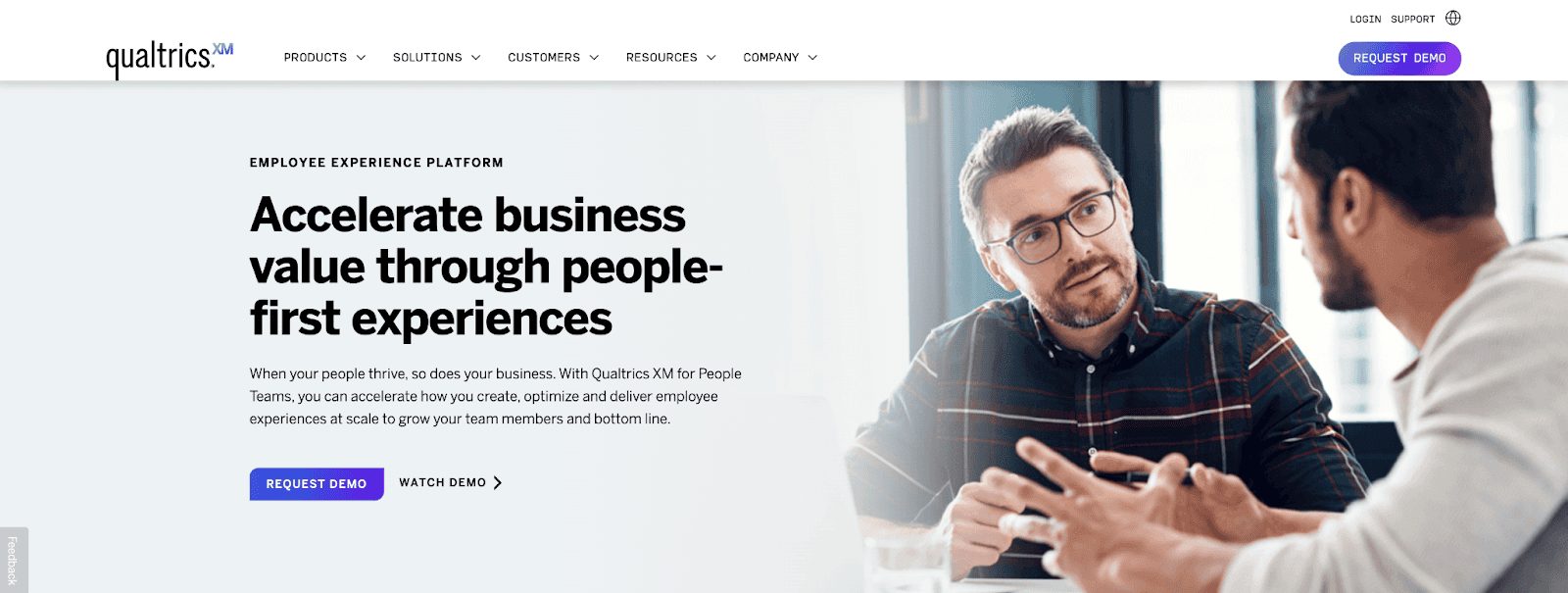
Qualtrics Employee XM is an AI-powered solution that uses employee feedback and insights to gain a holistic view of the various touchpoints in the employee lifecycle. It’s a platform designed with the belief that regular and insightful feedback can drive continuous improvement, leading to a highly engaged workforce and positive company culture.
It encompasses employee journey mapping throughout their tenure at the company — from onboarding to exit. These insights help organizations continually evaluate employee experience to understand trends and identify strategies that can be used to reduce employee turnover while also enhancing employee satisfaction.
Key Features
- AI & machine learning capabilities to analyze employee feedback.
- Customizable surveys with ready-made templates.
- Automation for 360-degree feedback on multi-rater performance reviews.
- Seamless integration with various HRIS systems, collaboration tools, and CRM software.
Pricing
- Contact sales.
3. Culture Amp — Best for Building Culture-first Organizations
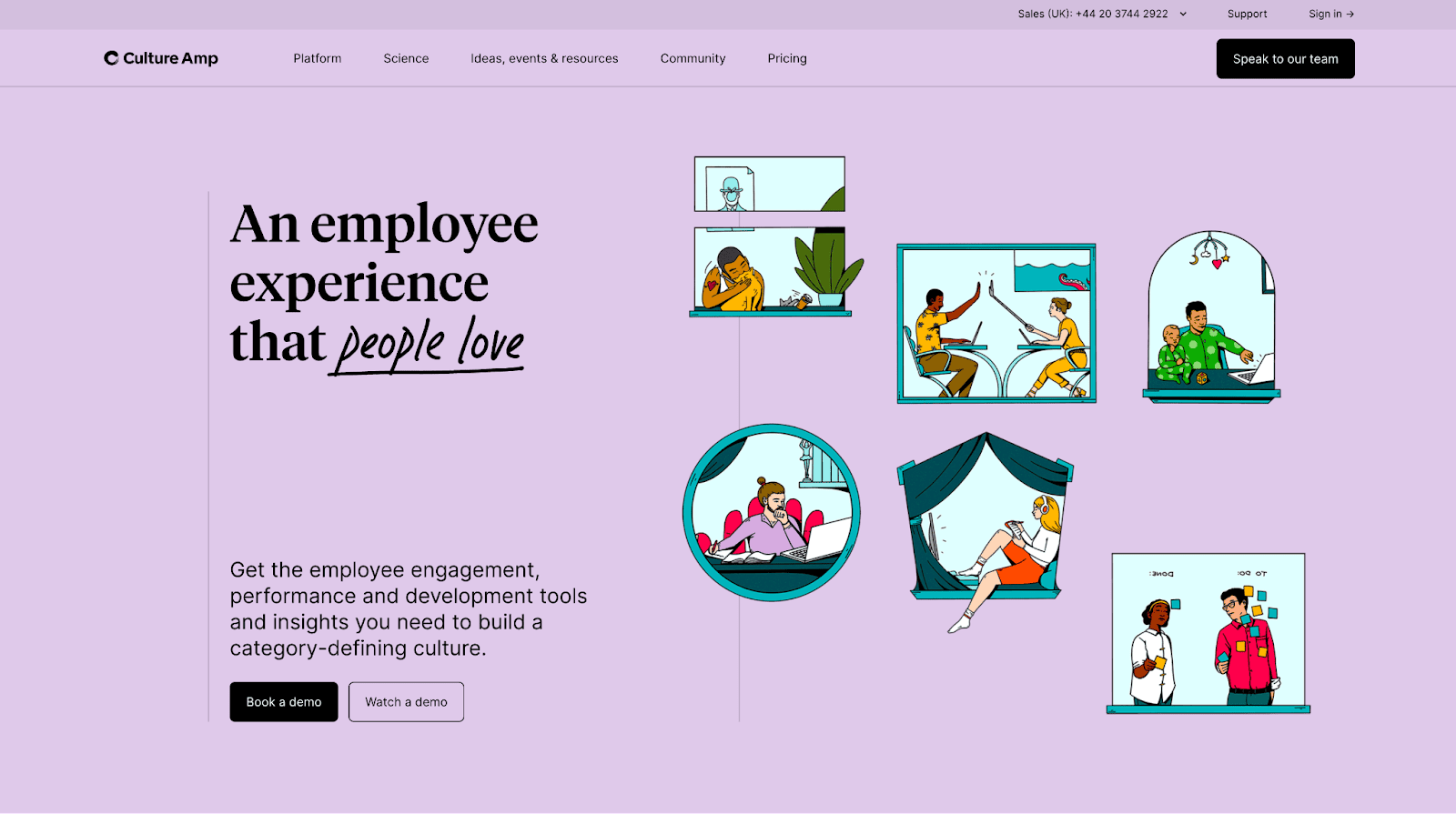
Loved for its science-backed approach to building a people-first company culture, Culture Amp is an employee experience solution that tracks employee engagement, performance management, and employee development.
The platform features 30+ science-backed and customizable survey templates to help you obtain accurate data on your employee engagement levels. Plus, you can use these surveys off-the-shelf or tailor them to your specific needs.
In addition, you visualize the survey responses via an intuitive dashboard to understand how employees feel about the company’s objectives, aims, goals, and overall culture.
Key Features
- Employee turnover prediction. Advanced algorithm to help you understand who’s at risk of leaving and why.
- Focus agent. It helps identify the highest impact areas to take action.
- Flow-of-work integrations. Allows for a unified platform by integrating tools such as Slack, Microsoft Teams, and several other tools to build a seamless workflow.
- Powerful feedback. Offers machine-learning powered tools and incorporates 360-degree feedback options that make it easy to evaluate employee performance.
Pricing
- Contact sales.
4. Motivosity — Best for Employee Recognition and Rewards
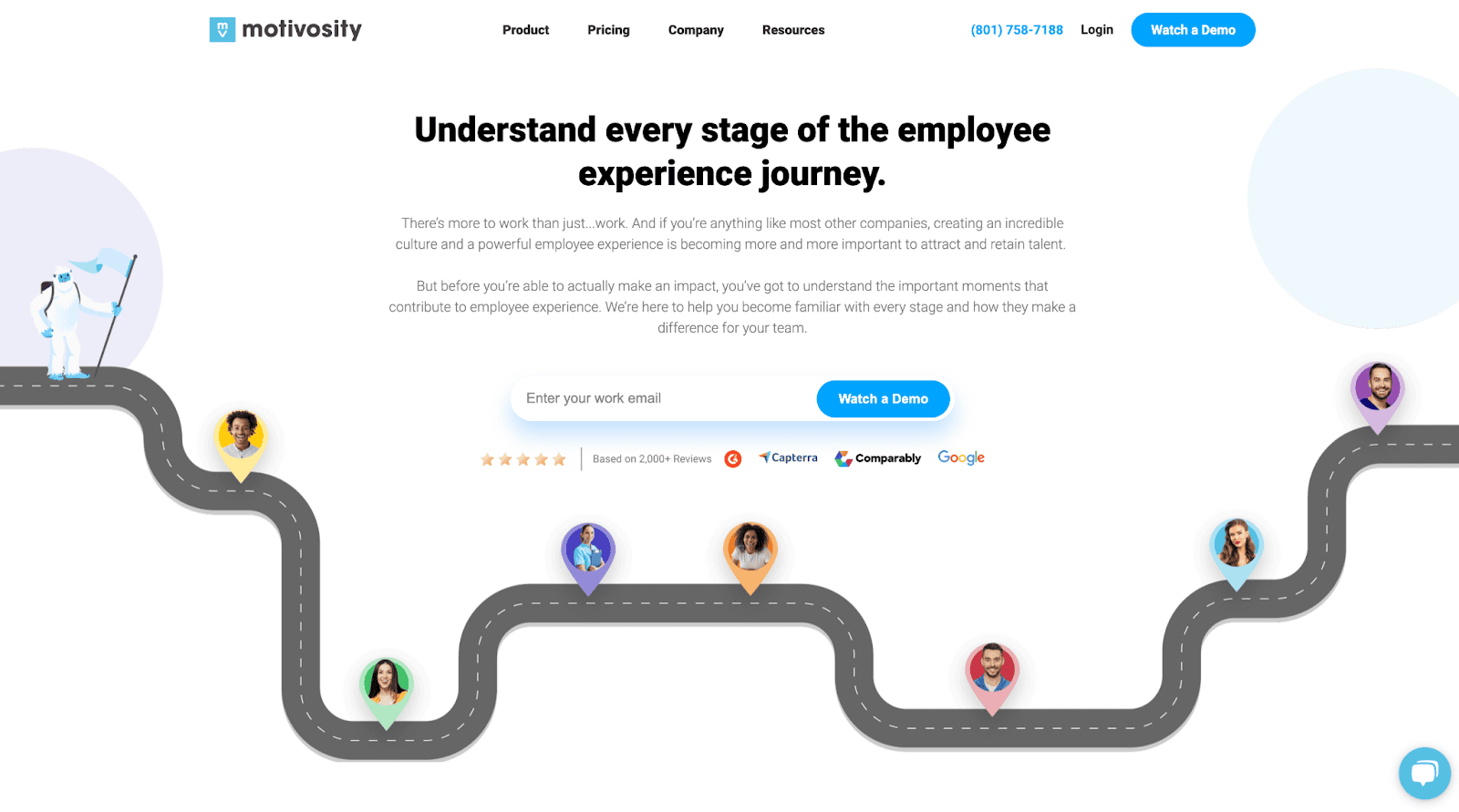
Motivosity takes its name from its core principle of “motivating employees” by creating a platform that supports employee recognition and rewards. It is designed around the philosophy that happy, recognized, and connected employees are more likely to be productive, stay in their jobs, and speak positively about their experiences at work.
Also, its newly introduced generative AI adds a personalized approach to employee experience through a new feature called ‘Coach Carl’ that helps managers produce high-impact, minimal-effort interactions that employees actually want.
Key Features
- Social feed. This company-based version of social media allows employees to post, share, highlight, like, and react to posts internally.
- Top-down recognition. You can use this to give or receive monetary rewards that can be redeemed for gift cards, tickets, or converted to cash.
Pricing: Motivosity has four plans based on its features.
- Community & Connection: $2 per employee/month.
- Recognition and rewards: $2 per employee/month.
- Manager development: $2 per employee/month.
- Employee insights: $2 per employee/month.
Related → 9 Proven Ways To Improve Company Culture
5. Vantage Circle — Best for Holistic Employee Engagement
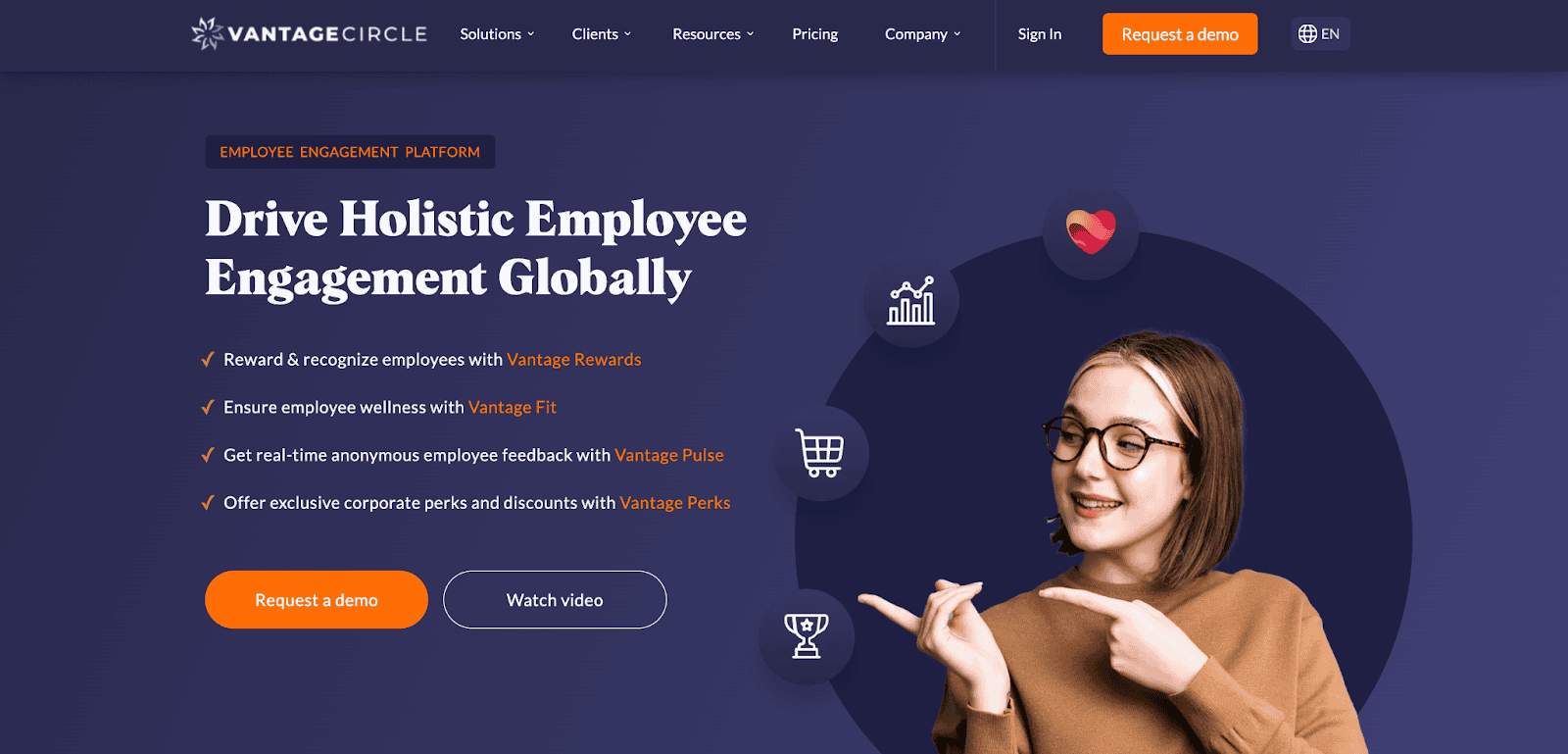
Vantage Circle is a platform that uses AI-based solutions to support HR teams in maximizing employee experience through recognition, wellness, feedback, and company benefits.
This is made possible with VantageCircle’s all-in-one suite:
- Vantage Rewards. This helps employees acknowledge the efforts, achievements, and contributions of each other, along with a flexible monetary and non-monetary reward system, making everyone feel valued and appreciated.
- Vantage Fit. This AI-powered employee wellness solution features wellness challenges such as weekly step challenges, walkathons, distance-based contests, and health campaigns to build healthy habits and encourage healthier lifestyles. It also integrates with wellness platforms and wearables like Google Fit, Samsung Health, Apple Health, Fitbit, Garmin, and the Apple iWatch.
- Vantage Pulse. This is an employee survey tool that gives you real-time insights into what your employee truly thinks about your company. This features eNPS-based surveys, pre-built survey templates, employee experience cycles, heat maps, feedback, comments, follow-ups, and internal benchmarks.
- Vantage Perks. This solution allows employees to enjoy company benefits and perks, enabling them to save on products and services. This includes cashback points, corporate discounts, and access to a global reward catalog featuring 1000+ brands across 59+ countries.
Pricing
- Contact sales.
6. 15Five — Best for Continuous Performance Management

Loved by employees, HR leaders, and managers alike, 15five boasts of a reputation as one of the employee performance management tools that maximize employee engagement, performance, and employee retention. The platform’s name, “15Five,” reflects the idea that it takes 15 minutes for an employee to complete a report and five minutes for a manager to review and respond to it.
Asides from that, 15five provides a framework for managers and employees to have meaningful conversations, set goals, track progress, and promote a culture of transparency and growth. It also offers pulse surveys and engagement metrics to measure employee sentiment and satisfaction. These surveys provide valuable insights into the organization’s overall health and help identify improvement areas.
Key Features
- 1-on-1s and Check-ins. 15Five’s platform includes a feature for setting up regular 1-on-1 meetings and weekly check-ins. This structure promotes consistent communication between employees and managers, which helps to address problems and opportunities in real time.
- Goals & Objective and Key Results (OKR) Tracking. The platform allows companies to set and track goals, objectives, and key results (OKRs). Each team member can automate their process through weekly check-ins or integrations with platforms like Slack, Jira, and Salesforce.
- 360-Degree Feedback. 15Five offers 360-degree feedback tools, allowing employees to receive comprehensive feedback from peers, managers, and direct reports.
- High Fives. An integral part of 15Five’s platform is its peer recognition feature, referred to as “High Fives.” This system encourages employees to acknowledge each other’s accomplishments, promoting positive and appreciative company culture.
- Professional Development and Coaching. The platform provides features to foster professional growth, such as a built-in coaching framework and coaching hub for managers to upskill
Pricing
15five offers four different plans.
- Engage. $4 per user/month billed annually.
- Perform. $8 per user/month billed annually.
- Focus. $8 per user/month billed annually.
- Total platform. $14 per user/month billed annually.
7. Workday — Best for Real-time Employee Engagement Analytics
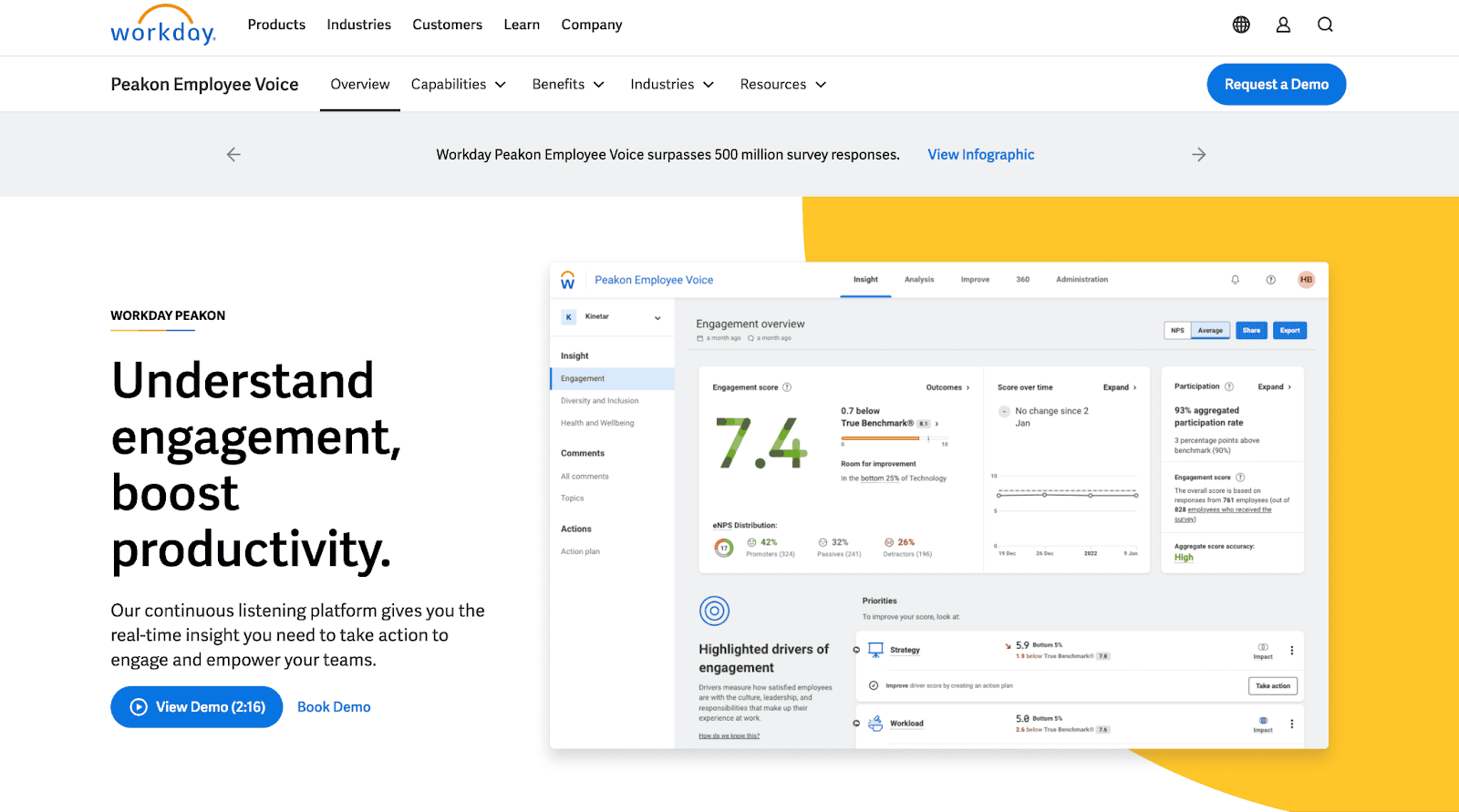
Workday is a continuous listening platform that gives real-time insights into areas in your organization you need to take action to engage and empower your teams. The platform boasts of unlocking the power of engagement through years of scientific research and organizational psychology.
With this platform, you can leverage its advanced Natural Language Processing (NLP) and Machine Learning (ML) capabilities to dive deeper into your employees’ minds and understand their sentiments about the organization. Managers can utilize this to have 1-on-1 conversations with employees to help surface issues and brainstorm relevant solutions.
The fully automated survey option on the platform also makes it easy for managers to ask the right questions and discover patterns across the organization to see what’s working and what needs improvement.
Key Features
- Integration with Workday Suite. As part of the Workday family, Peakon integrates seamlessly with the Workday suite of HR and finance applications. This means data can be shared across platforms, providing a holistic view of your employees and making aligning engagement initiatives with broader HR strategies easier.
- Segmentation capabilities. Workday Peakon allows you to segment the feedback data based on factors such as department, role, or location.
- Attrition prediction model. Workday helps you quickly identify trends and risks by department, location, age, and more using 20,000+ data points.
Pricing
- Contact sales
8. Lattice — Best for Performance Management and Employee Engagement
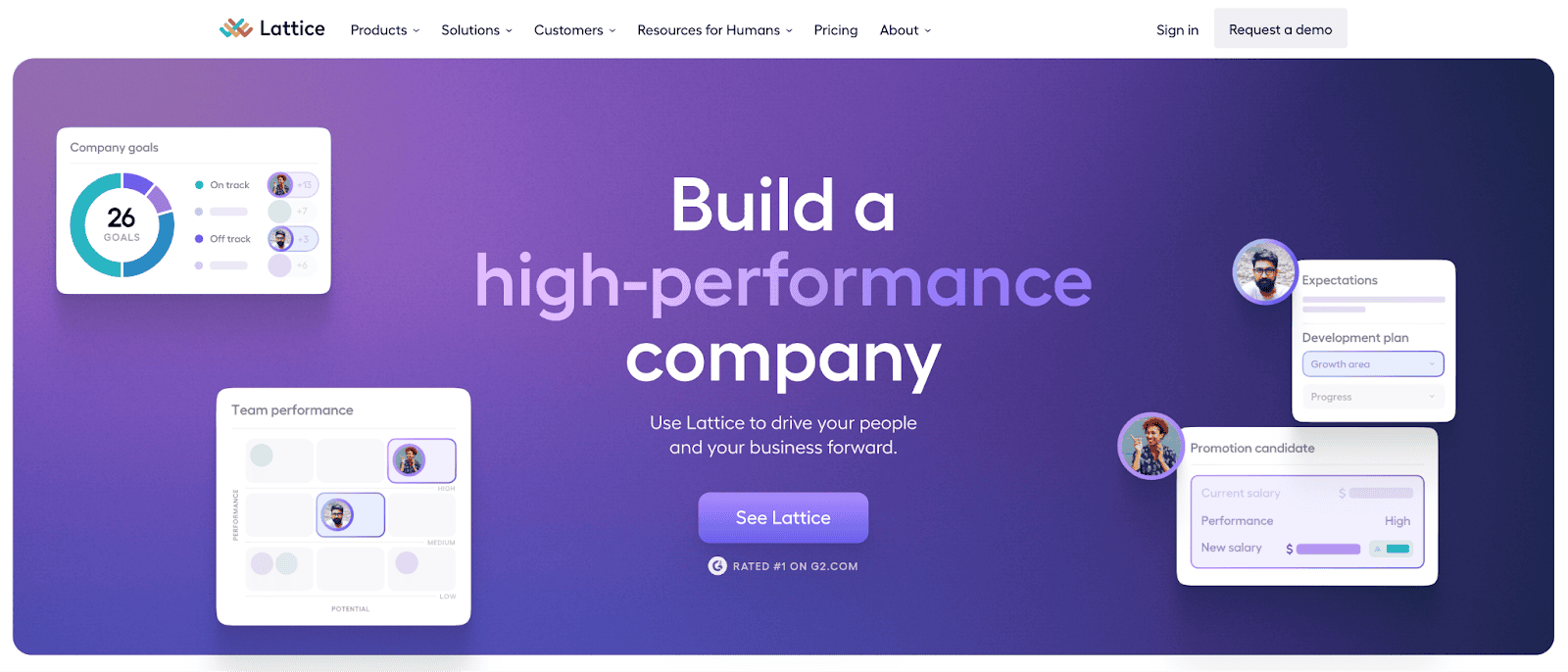
Lattice is the leading success platform for organizations looking for a comprehensive approach to a high-performance team with a core principle of ‘people first, business last.’ Its blend of continuous feedback, goal setting, and career development tools helps foster a culture of growth and engagement, significantly enhancing the overall employee experience.
Known as the ‘people success platform,’ Lattice unifies the entire employee experience, making it a one-stop solution for organizations striving to maximize their talent potential.
Key Features
- Effective 1:1 meetings. This includes action items, goals, feedback, and growth plans, allowing for a productive conversation.
- Continuous feedback option — to stimulate interaction between employees and managers.
- Career development plan. Lattice offers ‘Competency Matrices’ and ‘Individual Development Plans’ as a feature for creating and managing career development plans. This can help employees map out their career growth within the company, contributing to higher employee retention and job satisfaction.
- Praise is another feature that allows peers to celebrate outstanding achievements, performances, or contributions.
Other features include DEIB analytics, sentiment analysis, pulse surveys, and eNPS.
9. Quantum Workplace — Best for Measuring Employee Engagement
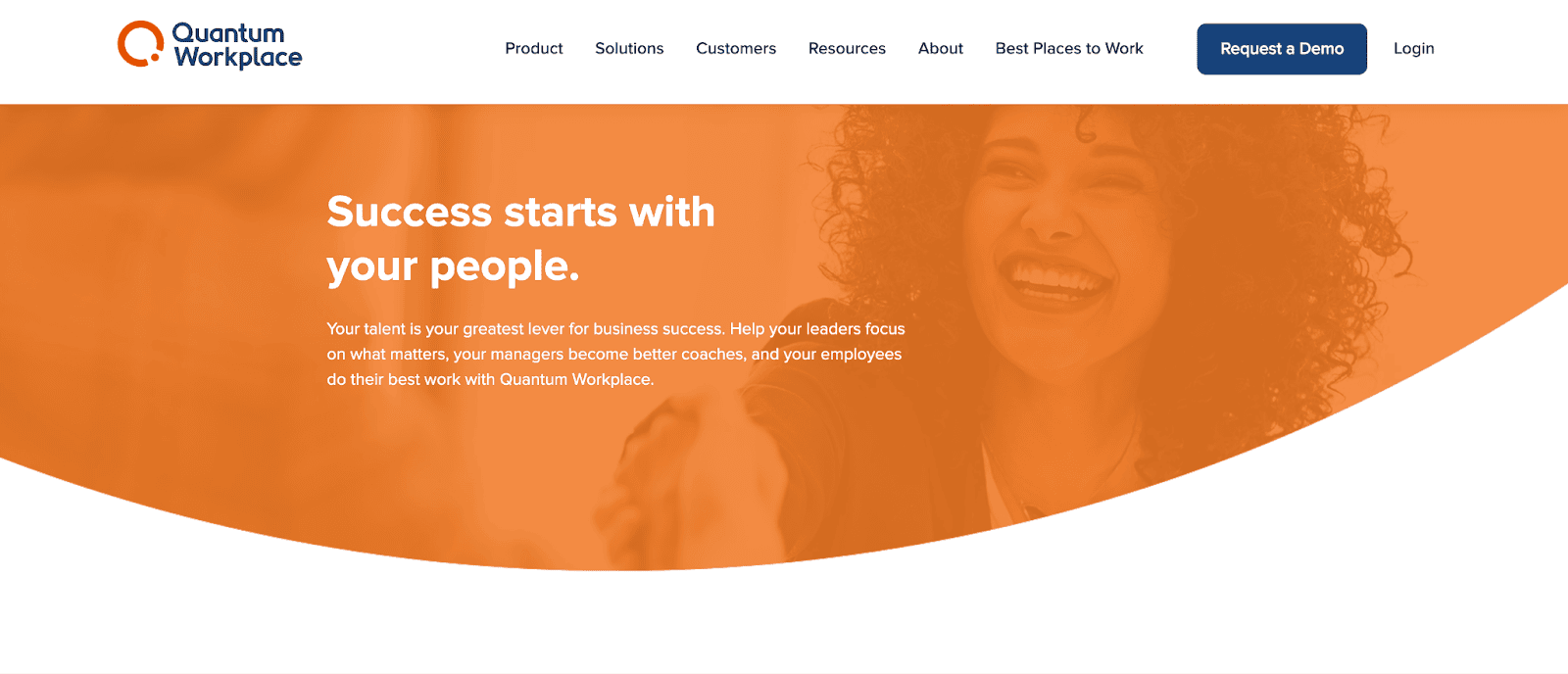
Quantum Workplace is an employee success platform that improves employee engagement, intelligence, and performance. The platform helps organizations understand engagement at every level, so it’s easier to pinpoint areas where their effort would have the most impact.
In addition, Quantum’s cross-platform intelligence feature helps you connect the dots so you can understand what engages and retains your top performers and maximize their potential in pursuit of business success.
Another notable function of Quantum is the people analytics and intelligence feature that provides insights on turnover trends, employee flight risk, text analytics, etc.
Key Features
- Succession planning. It helps you elevate top performers, identify talent risk and pinpoint successors to take on critical roles when needed.
- Engagement surveys. This includes pulse, onboarding, and exit surveys to understand employee engagement levels and collect actionable feedback. These tools can provide insights into the employee experience and guide strategies to enhance engagement.
- Recognition Tools. These are custom badges to promote a culture of appreciation. Employees can recognize their peers for their achievements and contributions, fostering positivity and boosting morale.
- Social news feed. This is a social intranet within the organization where employees can bond, congratulate, and motivate with intuitive and interactive features such as likes, comments, photos, and GIFs.
Pricing
- Request demo.
10. Microsoft Viva — Best for Employee Productivity
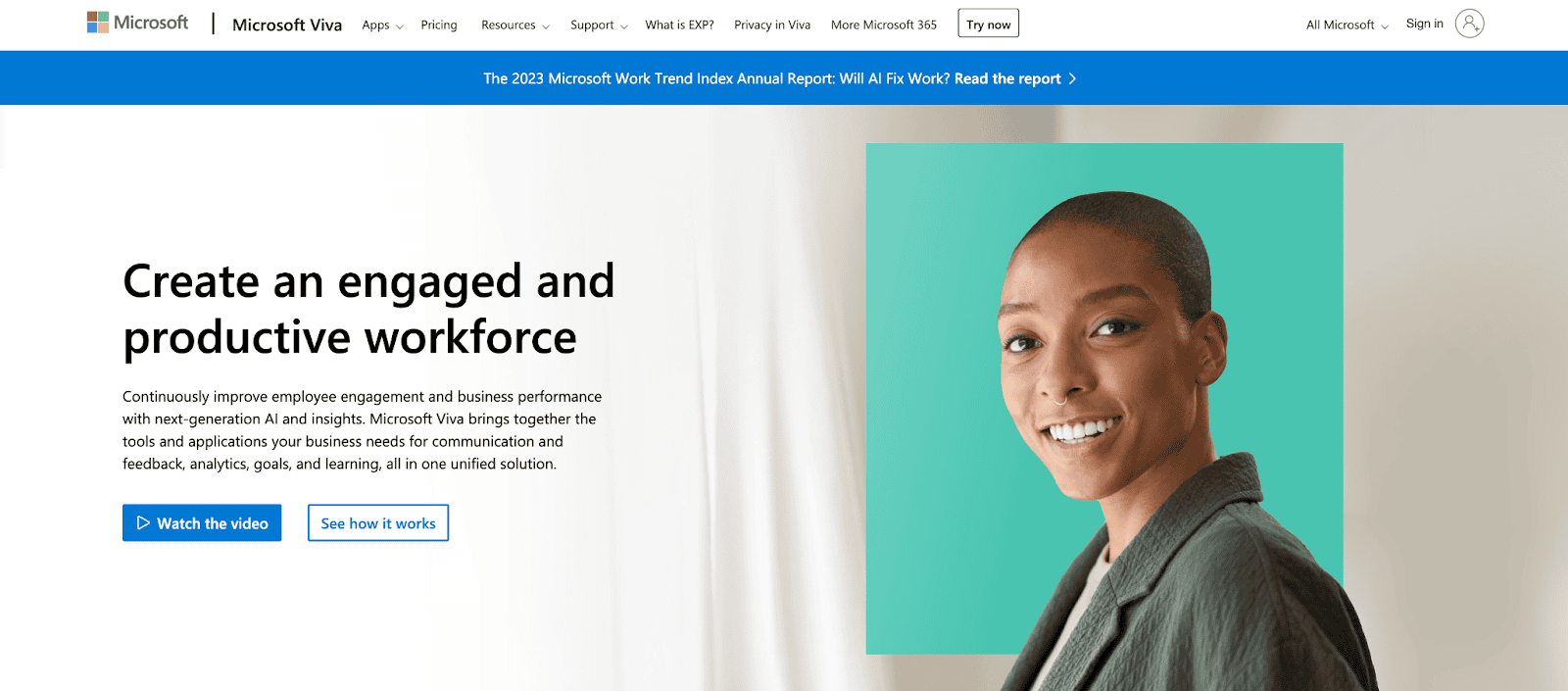
Microsoft Viva is an insightful employee experience tool aimed at improving employee well-being and workforce productivity.
It provides a centralized platform through its ‘communities’ feature for employees to explore company-related news, join conversations, and connect with others in other departments and locations.
Microsoft Viva also offers advanced insights that help businesses gain visibility into workplace activities, communication behaviors, and collaboration patterns to streamline decision-making and improve business performance.
Key Features
- Viva Topics. This uses AI to organize content and expertise across your organization, transforming it into shared knowledge. It automatically surfaces topic cards within conversations and documents across Microsoft 365 and Teams, making finding and sharing information easier.
- Viva Learning. This aggregates all learning resources in one place, making it easier for employees to find and access learning materials. For instance, employees can easily track learning assignments and recommendations, bookmarked content, learning collections, and recently viewed and completed courses in the ‘My Learning’ section.
- Integration with Microsoft 365 and Teams. As a part of the Microsoft ecosystem, Viva integrates seamlessly with Microsoft 365 and Teams. This integration means that all of its features can be accessed directly within the flow of work, increasing its effectiveness and adoption.
Pricing.
- Microsoft Viva Suite. $12 per user/month.
Ready to level up your organization’s employee experience? Join 1 million employees who use Workvivo to connect with their colleagues. ???? |
How to Choose The Right Employee Experience Platform
Choosing the right employee experience platform (EXP) can significantly impact your organization’s efficiency, productivity, and overall employee satisfaction.
However, with many available options, it can be challenging to select the one that best suits your organization’s unique needs. Here are some steps to guide your decision-making process.
- Identify Your Needs. Do you need a platform for improving communication, enhancing engagement, centralizing data, evaluating employee performance, analyzing experience — or a combination of everything?
- Evaluate Features and Functionality. Every employee experience platform prioritizes different capabilities — some have robust corporate learning management systems, others may excel in performance management, and some might offer comprehensive HR solutions.
- Review User Experience. Will the platform be usable? What’s the learning curve? Ensure you answer these questions to ensure the platform is easy to navigate for all users – from HR professionals to employees from various departments. A platform with a steep learning curve may result in low adoption rates, which defeats the purpose of implementing an EXP.
- Scalability. Your organization’s size plays a significant role when choosing an EXP. As your company grows, your EXP should be able to accommodate an increasing number of users, more complex processes, and larger data volumes.
- Integration Capabilities. The EXP you select should integrate seamlessly with your existing software systems (like HRIS, CRMs, Payroll systems, etc.). This will ensure a smooth flow of data and processes across systems, eliminating data silos and duplication of effort.
- Customer Support. A positive customer experience is crucial when implementing new HR technology. Choose a provider offering reliable, round-the-clock support to address any issues promptly. You can look for reviews and ratings by other users. They can provide insights into the platform’s strengths and weaknesses and the provider’s customer service.
- Pricing. Consider your budget and the pricing structure of the EXP. Be sure to understand what the cost covers and whether there are additional charges for extra features or services. Alternatively, since most providers offer a demo or a free trial, use this to get a hands-on experience of the platform’s functionality and usability.
Switch to Workvivo — A Workplace Experience Your Employees Will Love
What will it mean to you to have a work environment where employees are passionate and happy to share their passion?
Well, that’s how one million employees feel using Workvivo, and the Hoover Institution wasn’t an exception.
Workvivo: The Employee Experience Platform You Need
Workvivo stands out as an intuitive, engaging, and comprehensive employee experience platform that puts employees at the center of the equation.
The platform provides a social experience that employees are already familiar with. This similarity to social networks fosters higher adoption rates, ensuring that the technology brings value to all users across the organization.
Furthermore, Workvivo’s seamless scalability, integration capabilities, and mobile accessibility make it a versatile tool that fits perfectly into your organization, regardless of size or structure.
Switching to Workvivo means choosing to prioritize your employees’ workplace experience. Remember, happy, engaged, and valued employees are the cornerstone of any successful business.
